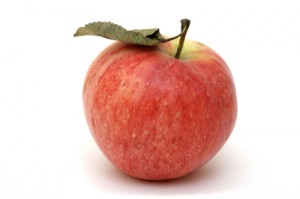
Ideally choose organic apples to avoid problems related to pesticide residues and other contaminants on the skins.
Apples are high in polyphenols [1] – a kind of chemical that (at least in theory) may protect against some common health problems and possibly certain effects of ageing.
Antioxidant Benefits
Most of the polyphenols in apples function as antioxidants – apples’ strong antioxidant benefits are also related to their ability to lower risk of asthma in numerous studies, and their ability to lower the risk of lung cancer.
Cardiovascular Benefits
The cardiovascular benefits of apples are well-documented in research studies, and they are closely associated with two aspects of apple nutrients: their water-soluble fiber (pectin) content, and their unusual mix of polyphenols. Total cholesterol and LDL-cholesterol are both decreased through regular intake of apples. In some studies, “regular intake” has meant apple intake very close to the level of one whole fresh apple per day.
Anti-Cancer Benefits
Preliminary results show apple benefits for several different cancer types, but especially in lung, colon and breast cancer.
Apples also contain quercetin [2] – a flavonoid [3], which is more concentrated in the skin than in the pulp. Recent research has shown that the quercetin content of apples also provides our cardiovascular system with anti-inflammatory benefits. (Our blood levels of C-reactive protein, or CRP, are reduced following consumption of apples and researchers believe that the quercetin content of apples is the primary reason for this drop in CRP.)
There’s an important loss of nutrients that occurs when apples are processed into applesauce, and an even greater loss when they are processed into juice. Some types of processing are easier on nutrients than others, but in general, apple sauces require boiling of apples and apple juices require some extraction of pulp. In all cases, the more apple that can be retained, the better the resulting nourishment.
Obviously, there are exceptions – for example, it is possible to put whole apples into a powerful blender and consume the resulting juice. In this case, very little if any of the nutrients are lost. However, this type of blending is not usually used in the commercial production of apple juice.
Commercial apple juices are typically either “clear” or “cloudy.” Clear apple juices have the vast majority of the apple pomace (pulpy apple solids) removed. Cloudy apple juices typically retain some of these pulpy solids because even though the pulpy solids have been removed from the juice through pressing and filtering, they are added back in at some designated level.
The polyphenol content of apples is also related to their easy browning when sliced open or bruised. Inside the cells of apple skin and pulp are enzymes called polyphenol oxidases, or PPOs. When the cells of the apple are sliced through or physically damaged when an apple is dropped, the PPOs start oxidizing the polyphenols in apples, and the result you see is a browning of the damaged apple portion. It’s important to handle apples delicately in order to protect their health-supportive polyphenols! (Also in this context, it’s worth mentioning that damaged apples not only turn brown from the oxidation of their polyphenols, but they also start releasing relatively large amounts of ethylene gas that can pose a risk to other undamaged apples. This phenomenon is why people say that “one bad apple can spoil the whole bunch.”).
To prevent browning when slicing apples for a recipe, simply put the slices in a bowl of cold water to which a spoonful of lemon juice has been added.
Nutrition Information
| Nutrition | per 100g | per apple | RDA women | RDA men | RDA child |
|---|---|---|---|---|---|
| Energy | 47 kcal | 47 kcal | 2% | 2% | 3% |
| Protein | 0.4 g | 0.4 g | 1% | 1% | 2% |
| Carbohydrate | 12 g | 12 g | 5% | 4% | 5% |
| Total Sugars | 12 g | 12 g | 13% | 10% | 14% |
| Total Fat | 0.1 g | 0.1 g | 0% | 0% | 0% |
| Polyunsaturates | 0.1 g | 0.1 g | |||
| Mono Unsaturates* | 0.0 g | 0.0 g | |||
| Saturated Fat* | 0.0 g | 0.0 g | |||
| Fibre | 1.8 g | 1.8 g | 8% | 8% | 12% |
| Salt | 0.0 g | 0.0 g | 0% | 0% | 0% |